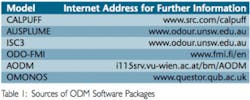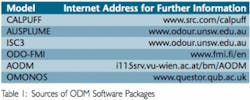Modelling software helps control odour problems
Download Odour Dispersion Modelling (ODM) software from the internet to help manage odour emissions from wastewater treatment plants.
Odour emission control in wastewater treatment facilities is a major issue for regulatory authorities and nearby residents. Strategies that use odour dispersion modelling and impact assessments help authorities predict and monitor odour problems.
Wind movement in the atmosphere can disperse odorous gases. Odour annoyance occurs when a person exposed to an odour perceives the odour as unwanted; the level of annoyance may increase to unacceptable levels and trigger a complaint.
The University of New South Wales in Australia defines the major factors to perceived odour annoyances as: offensiveness (a mixture of concentration, intensity and character); duration of exposure; frequency of occurrence; and tolerance and expectation of local residents.
An air dispersion model predicts downwind odour concentrations on the basis of odour emission rates, topography and meteorological data. The output from the model can be checked against odour impact criteria to derive an odour impact area. Within this area, it is reasonable to assume that local residents will experience some degree of odour annoyance.
Odour Dispersion Modelling (ODM) provides a benchmark for the prediction of the impact of odour. Modelling is most effective when a comprehensive study is carried out. ODM results should be validated by undertaking an odour community survey or an odour complaint history.
Odour Impact Assessment (OIA) is an effective tool used to prepare environmental management plans, and develop appropriate regional and local planning and development control instruments. OIA uses inputs of source odour concentration, ventilation rate, emission strength and topography information together with meteorological data and ODM to determine odour dispersion around the source. Odour impact areas can be defined by plotting odour concentrations corresponding to selected values for odour impact criteria.
ODM software packages are available from various sources. Table 1 lists six example models and sources where they are readily downloadable from the internet. Further details on each model are given below.
Developed by the US company Earth Tech Inc., the CALPUFF model is a puff dispersion model that simulates the effects of time-varying and space-varying meteorological conditions on pollution transport, transformation and removal. The US Environmental Protection Agency (EPA) approved CALPUFF as the preferred model for assessing long range transport of pollutants and their effects on Federal Class I areas, and as a specific basis for certain applications involving complex meteorological conditions.
The AUSPLUME model is a regulatory plume dispersion model developed in 1986. This model, developed in Australia, predicts the ground level concentration of any pollution or odours emitted from different point sources, area sources and volume sources.
The Industrial Source Complex (ICS) Model is a steady-state Gaussian plume model, which assesses pollutant concentrations from a wide variety of sources associated with an industrial complex. ISC models are especially designed to support US EPA regulatory modelling programs. ISC3 operates in short-term and long-term modes.
The ODO-FMI model evaluates maximum concentrations over short time intervals, allowing for atmospheric turbulence within the plume and the meandering of the plume. The modelling system includes methods to consider point, area and volume sources. Further details can be obtained from the Finnish Meteorological Institute (Table 1).
The Austrian odour dispersion model (AODM) consists of three modules. The first module calculates the odour emission of the source and the second estimates mean ambient concentrations by a regulatory dispersion model. The last module transforms the mean odour concentration of the dispersion model to instantaneous values related to wind velocity and atmospheric stability.
The Omonos model comprises a screening model for odour dispersion and predicts the probability of detection downwind of an odour source. The software can handle point, area and multiple source modelling.
Author's Note
Anthony Bennett is Managing & Technical Director at Specialist Technical Solutions Limited, UK. Contact [email protected], or visit www.specialist-technical-solutions.co.uk
Reference
University of New South Wales (2004), Odour Impact Assessment, Environmental Emissions & Odour Laboratory, Centre for Water & Waste Technology, The University of New South Wales, Sydney, Australia. Further information can be obtained from this link: www.odour.unsw.edu.au

